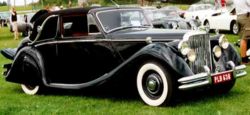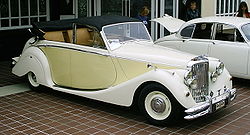
Jaguar Mark V
Encyclopedia


Jaguar Mark IV
The Jaguar Mark IV is a saloon car built by Jaguar from 1945 to 1949. It was a relaunch of a pre-Second World War model made by SS Cars Ltd from 1936....
designation was only given to the predecessor after the launch of the Mk V. It was perhaps a nod to Bentley who built 11 advanced Mark V saloons in 1939, resumed with the Mark VI in 1946-52 and dropped the "Mark" naming thereafter while Jaguars continued with the Mark VII to IX.
The car was launched at the 1948 London Motor Show at the same time as the XK120
Jaguar XK120
The Jaguar XK120 is a sports car which was manufactured by Jaguar between 1948 and 1954. It was Jaguar's first sports car since the SS 100, which ceased production in 1940.-History:...
, with which it shared a stand. However, the Mark V vastly outsold the XK120 by roughly 5,000 cars per year as compared to 2,000 cars per year for the XK120. While the XK120 had a new overhead-camshaft XK
Jaguar XK6 engine
The renowned Jaguar XK dual overhead camshaft inline 6-cylinder engine was introduced in 1949 and continued in manufacture until 1992. It was produced in five displacements for Jaguar passenger cars, with other sizes being made by Jaguar and privateers for racing...
engine, the Mark V retained the 1936 driveline including the "Jaguar" overhead-valve pushrod straight-6
Straight-6
The straight-six engine or inline-six engine is a six-cylinder internal combustion engine with all six cylinders mounted in a straight line along the crankcase...
2-1/2L and 3-1/2L units for which the company was renamed after the war. No 1-1/2L version was offered. Claimed power output in this application was 104 bhp for the 2664 cc Mark V and 126 bhp for its more popular 3486 cc sibling. The chassis was new with independent front suspension by double wishbones and torsion bar, an arrangement that would be used by Jaguar for many future vehicles. It also had hydraulic brakes, which Jaguar had been slow to adopt compared to other manufacturers, and an all pressed steel body.
The styling of the car followed prewar SS-Jaguar lines with upright chrome grille and the leaping Jaguar radiator cap mascot became available as an option. There is a distinct hint of the recently modernised Bentley
Bentley Mark VI
The Bentley Mark VI was the first post-war luxury car from Bentley.Announced in May 1946 and produced from 1946 to 1952 it was also both the first car from Rolls-Royce with all-steel coachwork and the first complete car assembled and finished at their factory...
look in the style of the front grill.
The wheels were 16 inches (406.4 mm) steel-disc type, significantly smaller than the 18 inches (457.2 mm) ones on the MK IV. From the side, a distinctive styling touch was a "tuck in" curve at the base of the rear window following the curved profile of the side glass. Rear-wheel spats (fender skirts
Fender skirts
Fender skirts, known in Australia and the United Kingdom as spats, are pieces of bodywork on the fender that cover the upper portions of the rear tires of an automobile.-Functions:...
) were standard. There was also a drophead coupé version which is now highly sought after.
A 3.5 litre car tested by The Motor
The Motor (magazine)
The Motor was a British weekly car magazine founded on 28 January 1903....
magazine in 1949 had a top speed of 90.7 mph (146 km/h) and could accelerate from 0–60 mph (96.6 km/h) in 20.4 seconds. Jaguar's inimitable test engineer Norman Dewis used a Mark V regularly. Recently asked about the top speed he saw in his car, he commented that he verified 90 mph once, but the thrill of the moment did not encourage repeating the feat. A fuel consumption of 18.2 mpgimp was recorded. The test car cost £1263 including taxes.
Production figures were:
- 2.5 litre saloon 1647
- 2.5 litre coupé 28
- 3.5 litre saloon 7814
- 3.5 litre coupé 977
In 1951 the Mark V was replaced by the Jaguar Mark VII
Jaguar Mark VII
The Jaguar Mark VII was a large four-door sports sedan launched by Jaguar Cars of Coventry at the 1950 London Motor Show. It replaced the Jaguar Mark V, but as there was a Bentley Mark VI already on the market, Jaguar decided to call the next model Mark VII...
. The Mark VII had the same 10 feet (3 m)wheelbase as the Mark V, but a longer and more streamlined-looking body, which continued in production with little outward change through the Jaguars Mark VIII and Mark IX
Jaguar Mark IX
The Jaguar Mark IX is a large luxury saloon car produced by Jaguar Cars between 1959 and 1961. It replaced the previous Mark VIII, and differed little in exterior appearance except for the new model name...
until 1961.
External links
- www.saloondata.com Volunteer register with records and photos of the Mk. V

